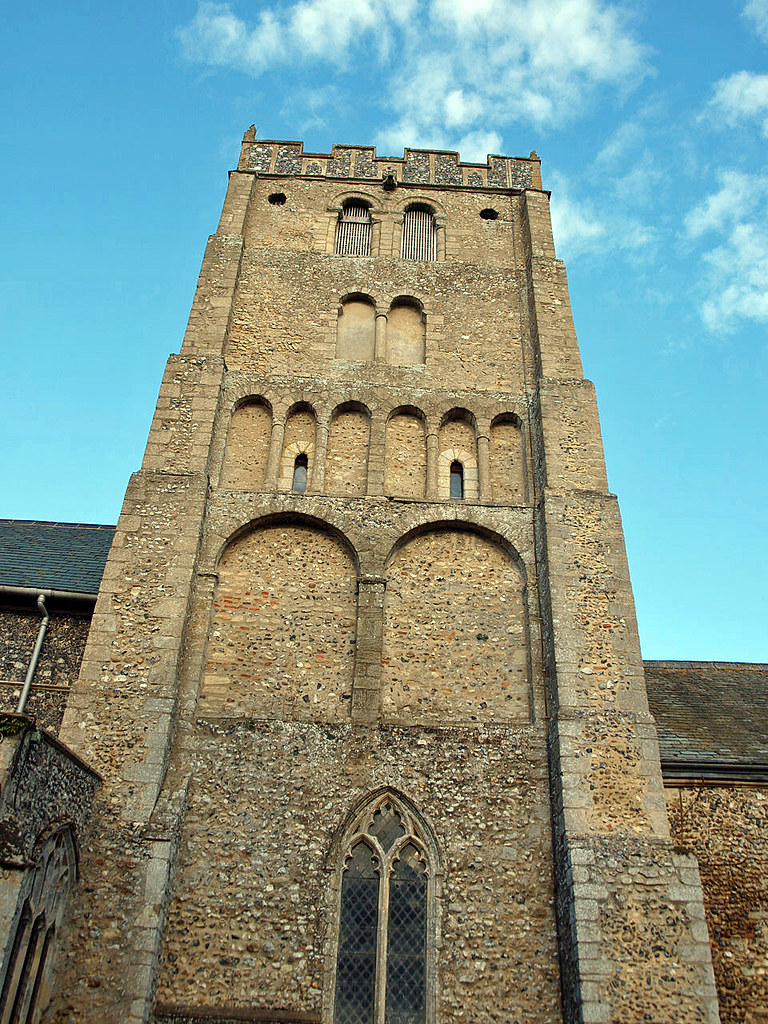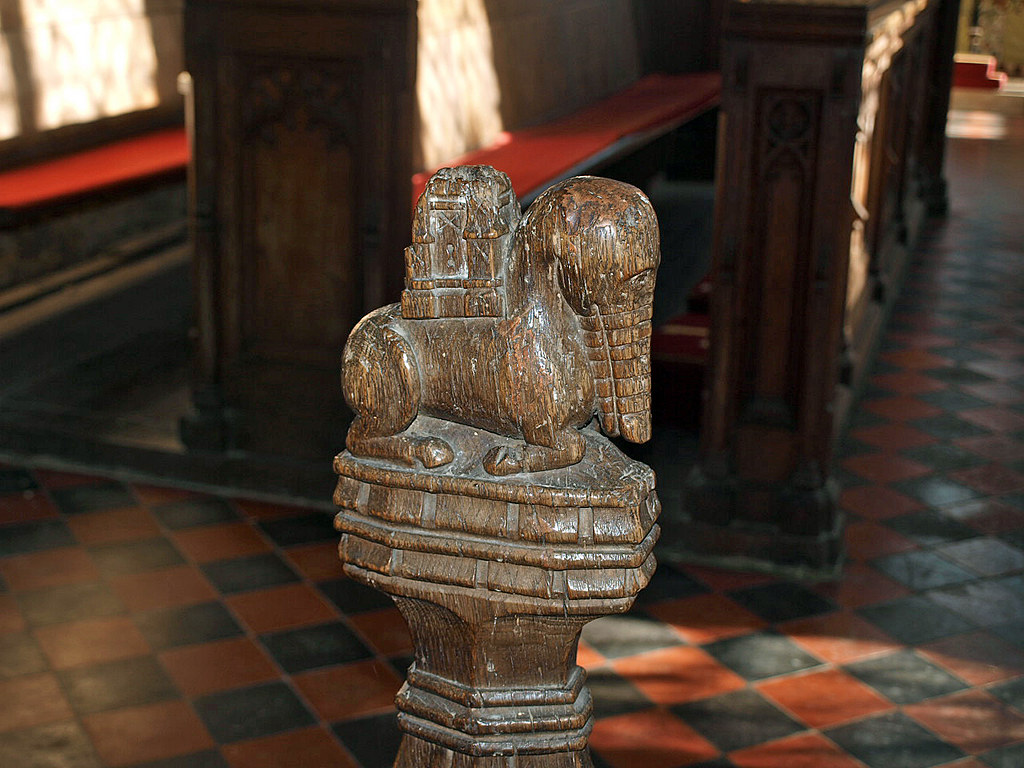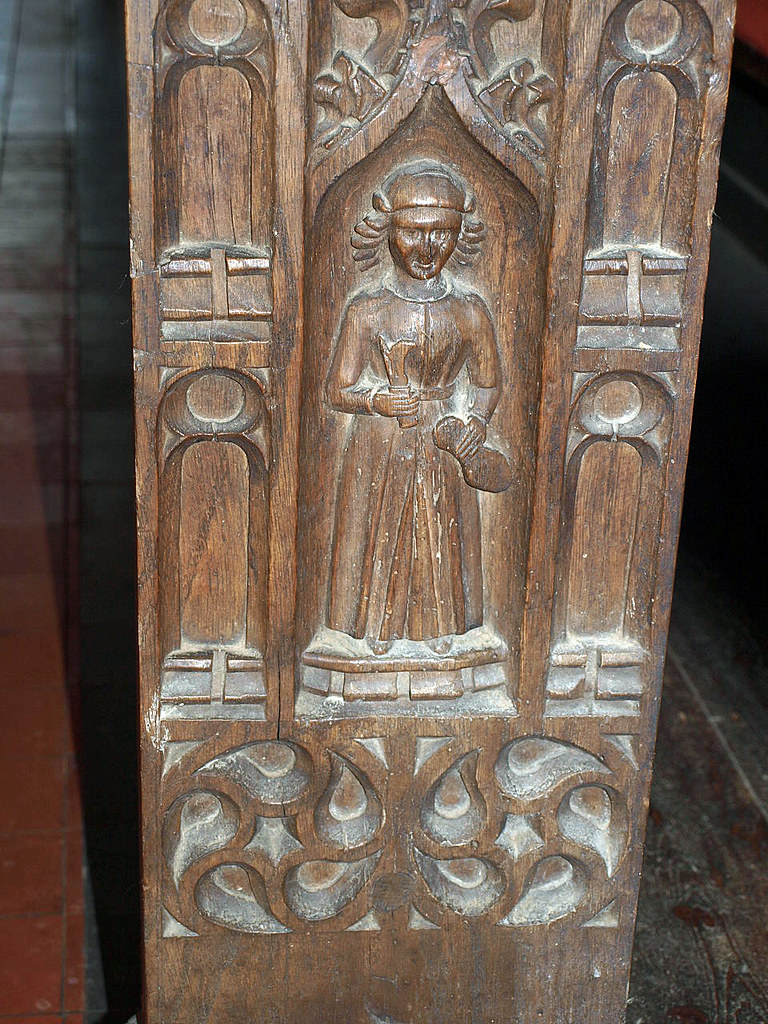ST ANDREW. South Lopham has the most powerful Norman tower of any Norfolk parish church. It is a central tower, and it is, to judge by its detail, no later than 1120, and perhaps earlier. It stands on a W and an E arch with strong shafts and low, broad block (not scallop) capitals and has one strong roll moulding in the arch. There are shallow N and S wall-arches too, and they may or may not indicate the existence or the intention of transepts. The former is unlikely considering the small S doorway set in the wall here no later than c.1200 and the lancet in the N wall. Externally the tower of South Lopham has four arched and decorated stages, but all the decoration is elementary. On the N side an oblong stair-turret runs up, completely undecorated. The arching is on the first stage simply two large arches with a pillar between, and they occur only on the N and S. There follow an arcade of three plus three smaller arches with single-scallop capitals and a middle pillar, then a two-light window, and above that the two-light bell-openings. The details can all be compared with the work of Losinga’s time at Norwich Cathedral, i.e. before 1120. The top is Perp flushwork-panelled battlements. The nave has Norman evidence too, the chancel has not. In the nave, N doorway with one order of shafts and zigzag in the arch, i.e. later than the central tower. But the final surprise of South Lopham is that to the W of that doorway there is, in the usual position fairly high up, a circular, unmistakably Anglo-Saxon window. So the central tower was added to a Saxon church of some size. The chancel is Dec, whether one can trust the renewed E window or not. The S aisle also must be Dec; see its windows and the four-bay arcade of roughly quatrefoiled piers with the lobes to nave and aisles having broad fillets, left without capitals (though the abaci take them in) and carrying arches with one hollow chamfer and one sunk wave. For the dating of the Dec parts Cox points to the record that Nicolas de Horton, rector from 1361 to 1380, was responsible for the chancel. That would give a remarkably late date for the survival of purely Dec forms, yet cannot be discounted. Big Perp W window, and prominent Perp clerestory of knapped flint with brick in the arches of the windows and lettered flushwork panels between the windows. Simple hammerbeam roof in the nave. In the chancel, roof of very low pitch with tie-beams on arched braces. - FONT. Octagonal, with very delicately cut, shallow tracery (cf. North Lopham). - BENCHES. The ends carry blank tracery. In one end a small standing female figure. Figures of animals and also a young man on the top instead of poppy-heads. - CHEST. A dug-out, 8 ft long, upstairs in the tower. - PLATE. Chalice (Norwich) 1567-8; Elizabethan Paten.
SOUTH LOPHAM. Its supreme possession is its Norman tower, the gift of a lord of Lopham who went down in one of the bitterest tragedies which ever cast a shadow round our throne, the sinking of the White Ship with the son of Henry the First on board as he was returning to England in his father’s hour of triumph. The village is charming, with an old forge, thatched roofs, and a pretty row of cottages facing the green. A road through fenland and over a common glorified with gorse, silver birch, and rushes brings us to the source of two rivers, the Little Ouse and the Waveney. They begin their journeys as rush-filled streams on each side of the road, and one flows west and the other east, dividing Norfolk and Suffolk.
Not only is William Bigod’s tower the glory of this village church, but it is the best example of Norman architecture in the county except for the cathedral itself. Built about 1110, it rises massive and magnificent from the middle of the flint-walled church, dwarfing the churchyard firs, and four of its five tapering stories are ringed with Norman arcading. There is a Norman doorway in the nave, and high up in the wall is a small round window deeply splayed, certainly Saxon and perhaps the work of the 10th-century builders. The rest of the church is mostly 14th century, but the porch and some of the fine windows are 15th. The clerestory windows of this time are on both sides of the nave, though there is now only one aisle, with its arches on clustered pillars. The roof has small hammerbeams and carving of Tudor flowers.
In the gallery of 15th-century carvings on old benches in the tower is a strange beaked animal with a castle on its back, a headless pelican with her young, winged animals, a seated figure in a veil, an animal sitting with another in its mouth, and a woman with a knife and a shoe. Parts of the medieval oak screen are now at each side of the east window. The font is old and has a Jacobean cover; the old chalice and paten were made by a Dutch craftsman, and the dug-out chest is a marvel, shaped out of a huge block of oak ages ago, eight feet long and probably as old as William Bigod’s tower.
The White Ship
WILLIAM BIGOD, who was among the three hundred souls who laughed and sang in the White Ship as she set sail from Normandy one November night in 1120, belonged to the famous family that had risen in a generation from the status of poor knights in Normandy to the possession of wide lands in England.
It was no cockleboat in which the son of Henry the First and his hilarious companions accompanied the king and the fleet, but a new vessel, propelled by the sweeps of fifty oarsmen. The high-spirited passengers had stayed ashore roystering long after the departure of the king, spurning with jests the priest who approached the ship to pronounce a benediction.
At last they swept out of the harbour, with a drunken pilot to steer them. Suddenly came a crash and a rending; the White Ship had been driven on to a rock and her side torn open. One terrible cry was heard by the fleet; then all was silence.
When the appalling news reached the king he swooned, and, as history tells us, he never smiled again. He was now left without a son, and so made the barons swear allegiance to his daughter Maud. There was, however, an heir to the Norfolk estates in Hugh Bigod, as consummate a villain as those lawless days produced.
Hugh Bigod hastened from the royal deathbed to declare that Henry had at the end disinherited Maud and appointed Stephen of Blois to succeed him. If pretext was needed, here was one for the long struggle by which England was torn in two. Hugh Bigod established something in the nature of a record by his treachery and his repeated passing from one side to the other as opportunity and advantage served.
However, he died in his bed, as hosts of his victims did not, and he was followed by a son who helped to wring Magna Carta from the wretched and reluctant King John.



No comments:
Post a Comment